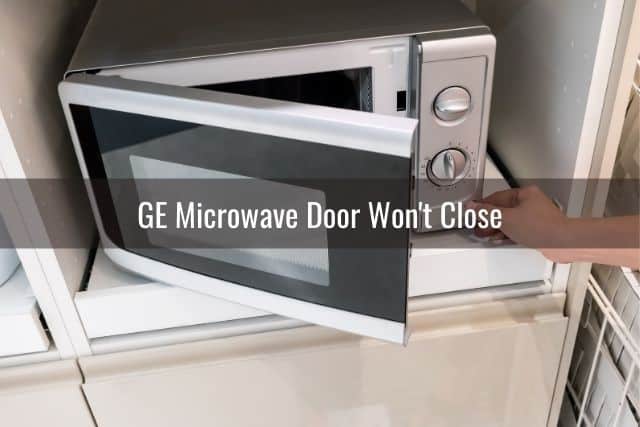GE Microwave Door Won’t Open or Won’t Close

In the United States, more than 90% of US households own a microwave. They are fast and convenient for heating and cooking foods, and for families that use them often, they may only last up to eight years before needing to be replaced. Given that many of the door components are made out of plastic, these are often the first to deteriorate.
If your GE microwave won’t open or won’t close, the most likely cause is a faulty or damaged door latch mechanism. This would mean a broken spring, cracks hooks, or even a damaged button that isn’t engaging the latch. These can be checked and replaced easily at home with parts ordered online.
This article will explore the causes behind your microwave door problems and some simple fixes that don’t require a maintenance specialist.
GE Microwave Door Won’t Open

The good news is that any door opening issues with a microwave are often damaged parts that are easy to replace. Rather than any internal electrical issues, plastic parts can be worn down over time and need to be replaced. To access these parts, you will probably need to unscrew the front panel.
Causes
Some common causes that could be preventing your microwave door from opening include:
- Broken door hook
- Broken door latch
- Broken door spring
- Broken opening lever/button/button spring
How to Fix
Each of the above issues can be manually checked without the need to call a professional. You will likely need to unscrew the door panel to access some parts, though. You might need to remove the door entirely for units that are mounted. Always ensure that the microwave has been unplugged before attempting any fixes.
Check the Door Hook
The door hook engages when the door is closed and is used as a safety feature to stop and start the unit. When the hook, or often hooks plural, is in place, a sensor will acknowledge that the door is fully closed and that the microwave can safely start.
Regular use can cause these plastic parts some damage or wear and should be replaced. However, the hooks are connected to the door latch as one part, which will need to be replaced entirely. In the video below, you can see how to remove the door to access the latch in order to replace it:
Check the Door Latch
The door latch sits inside the door and has hooks at the top and bottom that hold the door in place when the door is closed. If the latch is damaged or cracked, it will not sit properly in place and can prevent the door from closing all the way.
The latch can be removed and replaced in the same way shown in the video above.
Check the Door Spring
The spring in the door is used to provide tension. When the door is open, the spring holds the latch in place. As you close the door, the hooks will raise the latch to lock in place. This action pulls the spring until it is released once the hooks have engaged.
If the spring has failed, it is a simple fix. In the video below, you can see how to locate and replace a faulty spring:
Check the Opening Lever/Button/Button Spring
The opening lever is attached to the opening button behind the front side panel. Some models are simple plastic parts that push against the lever when the button is pressed. Some models have a spring system that can fail, much like the spring in the door latch.
Depending on the type of opening lever, you may need to replace the plastic part behind the button or remove and replace the spring.
GE Microwave Door Hard to Open

If your microwave door will open and close, but you are feeling resistance in the movement, the chances are that there is a buildup of residue on the mechanisms that are causing it to struggle. If the door remains closed and opens when the button is pushed, the latch, springs, and buttons are probably in working order. This can be fixed easily at home.
Causes
The kitchen is full of grease, moisture, and food particles, such as flour and sugar. It is not uncommon to find residue building up on areas that are often not clean. Moreover, your microwave is exposed to all kinds of food, splatter, and debris. This can build up over time in cracks and under cleaned locations.
How to Fix
Start by unplugging the microwave to prevent any shocks or accidents. Thoroughly clean the microwave, being sure to get into any cracks that can be seen around the seal. Once clean and completely dry, spray the door latch and button with White Lithium Grease. This will lubricate the mechanisms to prevent sticking and act as a barrier against future residue.
GE Microwave Door Latch Release Broken

The door latch release is a small part inside the microwave’s front that will hold the hooks in place when the door is closed. As you push the button, the part behind the button or the spring attached will disengage the latch release, allowing the hooks to lift and open the door. They are often small parts that can be difficult to get to.
Causes
Much like all the other plastic parts of the microwave, over time, it is not unusual to see parts wear out or become damaged through use. The latch release is engaged every time the door is opened and closed and can crack or break in the same way the door hooks can.
However, the release is often located behind the control panel, making it slightly more challenging to identify and replace.
How to Fix
To access the latch release, you may have to remove the entire front panel of the microwave. With the unit completely unplugged, remove the control panel, which is usually located on the front right of the appliance.
Once the panel has been removed, you will need to unplug any wire connecting the buttons and pull the door latch free from behind the front wall. The latch is a small part that can be ordered online.
In the video below, you can see how to locate and replace the latch release:
GE Microwave Door Won’t Latch

If your GE microwave door won’t close, the most likely cause is a fault in the door latch or hooks. As mentioned above, if the spring fails or the hooks become damaged, they will not engage properly.
If the spring has failed, the latch might not be lifting high enough to allow the hooks to set into place. Similarly, if the latch or hooks are broken, they might not fully engage when the door is closed.
Both can be fixed in the same way mentioned above.
GE Microwave Door Won’t Close

If you have checked that the latch is in working order, your microwave door might not be closing due to debris or fallen food. In some cases, food particles can drop into the cracks around the door, preventing the latch from hooking into place. You might also see some debris in the area around the hinges.
Causes
Food particles can fall from bowls and plates when being moved in and out. Sometimes, if the food is uncovered, it can bubble and pop up during cooking. These small food particles will harden over time and can make their way into hinges, the seal around the door, and even the latch mechanism.
How to Fix
Thoroughly clean your microwave, including the tracks around the edges, the lip on the bottom, the hinge area, and the latch components. Even the smallest pieces of food, when hardened over time, can get in the way. Also, remove the plate and clean underneath to be sure no remaining particles can move over time.
GE Microwave Keeps Running When Door Is Closed

The vast majority of microwaves have a sensor inside that will stop the unit from working if the door is opened. This sensor is activated when the door is closed and the latch and hooks are in place. Other than a problem with the sensor, the issue could be electrical.
Causes
A common reason that your microwave continues to run when the door is closed is a fault in the sensor. Once engaged, this sensor allows the microwave to run. If this sensor is faulty, it could be sending false signals for the microwave to continue, even after the cycle has ended. It might even continue when the door has been opened.
Another issue could be with the control board inside the appliance. If the unit continues to run even after you push stop, there is likely a problem with the control board.
How to Fix
Both the sensor and control board are electrical components, and if you are not confident in handling these parts, you should call a maintenance specialist to perform a service. However, if you are confident and have unplugged the unit, you can access both of these via the front panel.
The sensor should be tested with a multimeter for continuity. You are trying to check that the part is in working order by testing the electrical currents running through. If the multimeter gives back no reading, the sensor will need to be replaced.
The control board can be tested in the same way, though this should be done by those very familiar with electronics. If the board has no continuity, it will need to be replaced. However, removing this might void your warranty, so always check the paperwork beforehand.
Final Thoughts
A microwave door that will not open or close correctly is likely suffering from broken or damaged plastic parts in the door latch mechanism, such as the internal springs or the hooks used to engage the start sensor. These can be found by removing the door and front panel once the unit has been unplugged. New parts can be found online or in most hardware stores.
Related Articles

GE Microwave Not Heating Up Food
GE Microwave Touchscreen Not Working